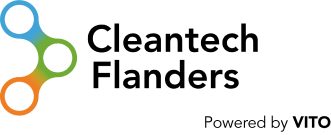Flanders is among the leaders in Europe in the transition to a circular economy. This is already making itself felt in practice in a range of different sectors. Not least in waste processing.
Global warming is not just an energy problem. On the contrary, the extraction of raw materials and the transport, production and use of materials and goods account for 60% of global greenhouse gas emissions. The sustainable management of our planet’s material resources is therefore crucial. And this management requires circular economic strategies and applications. It is no exaggeration to say that the transition to a circular economy is also a transition to a more liveable planet. This is in strong contrast to an economy based on business-as-usual, where the use of the earth’s natural resources continues unabated.
Stepping up the efforts
Flanders has understood the stakes. ‘Circular’ here is no longer just an idea or a theoretical concept. It is already being put in practice in a wide range of different sectors. All thanks to the many stakeholders developing circular solutions, helping scaling them up, bringing them to the market or – on the other side of the economic spectrum – putting them into use. Some of these solutions are cleantech innovations: these are products and services driving forward the still fledging circular economy in Flanders. When it comes to ‘circularity’, Flanders is in the European vanguard. It can only maintain its leading position by stepping up its efforts.
Flanders may be a relatively small region, but it is very strong in economic terms. It owes this strength in no small part to its geographical location and the major ports that make Flanders a logistical hub for primary raw materials, semi-finished and finished products. At the same time, there are various opportunities to make the economy circular.
Flemish companies are getting better and better at creating so-called ‘added circular value’. They do this by designing products smarter, so that they can be easily repaired, upgraded, disassembled or transformed into other, new products. The materials used come from recycling or have bio-based origins. And of course, they are also recyclable or biodegradable when the products reach their end-of-life.
When is an economy circular? When is it circular enough? The second question is difficult to answer, because the more circular, the better. But 100% circularity simply goes against the laws of nature. Nevertheless, that is no excuse for lowering the ambitions. For example, Flanders intends to reduce its materials use by 30% by 2030 (compared to 2010). It is a challenging resolution, and it is also clear. The latter aspect is important, in order to get as many stakeholders as possible on board, and give them the opportunity to fully familiarise themselves with the circular world. Circular Flanders, the Flemish government’s support centre for the circular economy, is facilitating and closely monitoring this transition.
Thematic Agendas
Circular Flanders was set up in 2017 as part of the Public Waste Agency of Flanders (OVAM). The public-private partnership is steered by around 20 organisations: governments, companies, research and financial institutions and civil society organisations. It simultaneously acts as a hub, matchmaker and source of inspiration for the Flemish circular economy. In the early years, Circular Flanders primarily focused on raising awareness and forging early partnerships between relevant stakeholders. But it also supported pilot projects and initiatives for more knowledge creation.
Once the groundwork was done, the focus shifted to scaling up circular innovations and familiarising organisations with the ‘circular’ ethos. Since last year, the public and private partners within Circular Flanders have been working closely together within specific ‘Thematic Agendas’, which focus on concrete milestones and goals. These Agendas are tailored to Flanders: they focus on the aspects in which our region excels: circular construction, circular chemistry and plastics, water, bio-economy and the food and manufacturing industries. ‘Acting in a circular way requires intensive cooperation’ is the maxim that links the various agendas. Each Agenda has a public and a private leader, complemented by a community of relevant stakeholders. Working together in co-creation, they ensure that circular strategies and applications are incorporated as much as possible in the specific thematic fields.
Cooperation within the Thematic Agendas will be further enhanced in 2022. There will also be an even stronger focus on concrete action. Nevertheless, the door remains open for stakeholders who are interested but not yet involved. Circular Flanders will also work closely with various expert groups to remove the obstacles in the transition to a circular economy and make faster progress. The levers it uses in this regard a legal and fiscal framework, financing of circular strategies, circular procurement procedures, research and innovation, new business models and jobs and skills in the emerging circular economy.
The Circular Flanders team is predominantly a facilitator for cooperation in the ‘circular’ domain. At the same time, the Circular Economy Policy Research Centre, together with VITO, provides scientific underpinnings. This is complemented by a so-called barometer to monitor progress in the ‘circular’ domain. The Flemish CE Monitor was launched on 22 November 2021, with around a hundred indicators showing the impact of all the efforts towards the circular transition on the Flemish economy and society.

Brigitte Mouligneau, Transition Manager at Circular Flanders

Sloopwijzer-tool brengt materialenstock in kaart
The ‘Demolition guide’ (Sloopwijzer) tool provides an overview of material stock
Flanders wants to reduce its use of materials by 30% by 2030. Circular construction can contribute to this by reusing or recycling materials and raw materials from demolished buildings as much as possible. To facilitate this approach, VITO developed the ‘Demolition guide’ (Sloopwijzer) tool to smarten demolition. The tool estimates the material stock of a building, district or entire city or municipality. For example, the tool provides insight into which materials and raw materials (and in what quantities, weights and forms) go into and out of a given area. Such concrete information is precisely what is needed for sectors like waste processing and recycling, as well as construction and the transport sector, to encourage entrepreneurship with a more circular approach. That way, the companies in these sectors know what to expect, so that they can focus their activities accordingly.
The ‘Sloopwijzer’ tool works on the basis of images of house and building façades taken from the street, for example by Google Street View®. Artificial intelligence is applied to these images to recognise specific construction elements such as windows and window profiles, as well as specific materials. The tool was rolled out in the city of Leuven last year and works semi-automatically. Some human intervention is necessary for selecting the images in the tool software, but after that everything runs automatically. The tool’s ultimate output indicates how much of a given construction element or material is present in a building.
To obtain an aggregated result for a ‘scanned’ area and find out how the exact quantities of construction elements and materials are distributed across the local building stock, however, further development is needed. This information may be of interest not only to the above-mentioned businesses, but also to policymakers. Policymakers can then use it as a basis for market economy studies for renovations.
80% reliable
In the coming months and years, the ‘Sloopwijzer’ tool will be further fine-tuned. There is still some room for improvement. There is a considerable technical challenge: façades of houses or buildings need to be clearly visible, for example, and this is often not the case due to parked cars or trees. In addition, the algorithm being trained on thousands of images of construction elements and materials through deep learning is not perfect. At present, the reliability of the tool is between 80 and 90%. This means an average of 10 to 20% of detections are still errors.
Using street images is therefore an asset for the ‘Sloopwijzer’ tool. Indeed, besides Google Street View®, cameras can be used on vehicles that frequently pass through streets in any case, such as bin lorries, Post Office bikes and cars, and public transport.

Yoko Dams, Research team lead VITO



